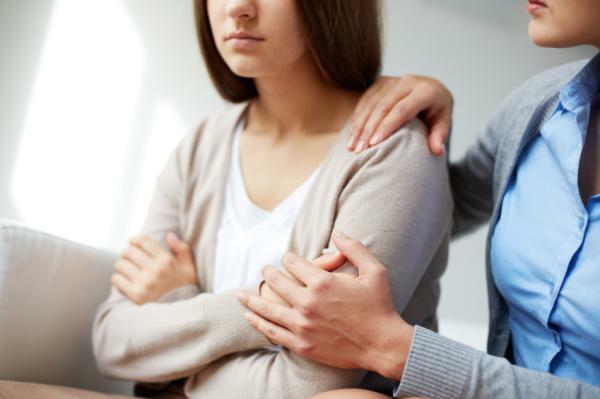
Being close to a person can be a source of concern. Regardless of whether or not we know that person, we can feel strange if we share the same place or a certain activity. With the pandemic, social distance has been one of the main regulations that has been installed in order to prevent the spread of Covid-19. Regardless of this, some people feel discomfort when touched. This causes them discomfort, but it can turn into a strong and intense fear that makes it difficult to carry out daily activities, as well as social relationships.
It is important to have accurate and concrete data to deal with this problem. Probably something like this has happened to you or you know someone who has had this kind of sensation. Do you want to know more about this? In this Psychology-Online article, we will provide you with information about the Hafephobia (fear of physical contact): what is it, symptoms, causes, treatment.
Index
- What is haphephobia
- Symptoms of haphephobia
- Causes of haphephobia
- Treatment of haphephobia
What is haphephobia.
Haphephobia, or fear of physical contact, corresponds to a anxiety disorder in which there is a irrational and exacerbated fear of being touched by other people. According to the DSM-V[1], it is possible to place this clinical picture within the group of specific phobias given its characteristics and presentation particularities.
In order to understand specific phobias, the DSM-V mentions a series of diagnostic criteria that must be met:
- Intense fear or anxiety of being touched by another person.
- The situation almost always provokes fear or anxiety.
- Avoidance of touching other people.
- Fear or anxiety out of proportion to the actual danger posed by physical contact with others.
- Symptoms last six months or more.
- The lack of physical contact deteriorates work, social and family relationships.
- The fear or anxiety is not linked to another mental disorder.
Symptoms of haphephobia.
Haphephobia presents itself through a series of manifestations that appear both physically and emotionallyl and behavioral of people suffering from this disorder. The importance of knowing this data lies in the fact of detecting the problem in time and thinking of effective strategies to address it.
Next, we will place the main symptoms of haphephobia:
- Catastrophic thoughts in relation to being touched.
- Difficulties in concentration and memory. In this situation, you can consult these strategies to improve concentration.
- Sleeping problems.
- Avoidance of social situations.
- Incrise of cardiac frecuency.
- sweating
- Sickness.
- dizziness.
- vomiting.
It should be noted that the presence of any of these symptoms does not necessarily represent a picture of haphephobia. The diagnosis must be made by a mental health professional, since he will be in charge of evaluating the clinical conditions of the patient.

Causes of haphephobia.
Although it is transcendental to know the symptoms of hafephobia, the truth is that it is also important to locate the origin of this mental disorder, given that this will allow the problem in question to be adequately addressed.
In the following lines we will talk about the major causes involved in fear of physical contact:
- Environmental factors: the experiences that a person has had in her life make up a trait that can be decisive in the behaviors, thoughts and emotions that she has. In this way, if a person has experienced an unpleasant situation in the past related to physical contact, it is possible that they will develop a picture of haphephobia. In short, there are situations like physical abuse and/or punishments that can influence. Moreover, here the imitation of behaviors of members of the family environment plays an important role.
- Genetic factors: the transmission of genes by parents is associated with the emergence of hafephobia. Therefore, it is possible that the person has greater sensitivity in terms of neural connections linked to the processing of information from the environment. This can cause fear as a response to stressful situations.
Treatment of haphephobia.
Although haphephobia, or the fear of physical contact, produces difficulties for the person who goes through this condition Clinically, there are treatments available that have been shown to be effective in curing this condition. pathology. In the next items we will talk about how to treat haphephobia.
psychological therapy
Therapy is a space that invites personal reflection about life situations that generate conflicts. In general, the therapy works on the thoughts, emotions and behaviors that are involved in the symptoms.
In the case of haphephobia, the main focus lies on build new tools to address the fear of being touched. Both short-term therapies and cognitive behavioral therapy, like the most extensive therapies, have been shown to have good prognoses in cases of haphephobia.
psychiatric medication
In cases where the fear of physical contact is very serious, it is advisable to resort to provision of anxiolytics to reduce the intensity of symptoms. However, the consumption of psychoactive drugs should only be done under the supervision of a mental health professional.
If you want to know more, in this article, we show you the types of anxiolytics that exist.

This article is merely informative, in Psychology-Online we do not have the power to make a diagnosis or recommend a treatment. We invite you to go to a psychologist to treat your particular case.
If you want to read more articles similar to Hafephobia (fear of physical contact): what is it, symptoms, causes, treatment, we recommend that you enter our category of Clinical psychology.
References
- American Psychiatric Association. (2013). Diagnostic and Statistical Manual of Mental Disorders (5th ed.). Arlington: Pan American Medical Publisher.
Bibliography
- Bados-López, A. (2005). Specific phobias. Faculty of Psychology. Department of Personality, Assessment and Psychological Treatment.
Hafephobia (fear of physical contact): what is it, symptoms, causes, treatment


